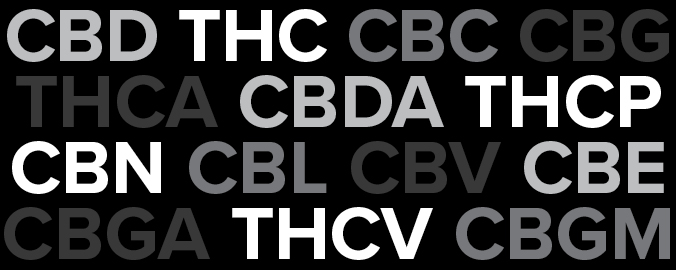What are cannabinoids and what do they do?
Last month we talked about terpenes, the endocannabinoid system, and the entourage effect. Now it’s time to get deeper on a molecular level and talk about cannabinoids. If you’re wondering what cannabinoids are, they’re molecules that activate the receptors in your ECS, which in turn is how you feel the effects of cannabis. Your body already produces endocannabinoids, but cannabis produces phytocannabinoids—more specifically cannabinoid acids—which, when decarboxylated, produce the most well-known cannabinoids, THC and CBD.
More than 100 individual cannabinoids have been identified in cannabis, and they each have a different effect on the body. Remember that to-be-proven theory we talked about, the entourage effect? This is where all the cannabinoids, terpenes, and other compounds stimulate different receptors in the human body’s endocannabinoid system to give users a nuanced, custom cannabis experience.
You may have already heard of some cannabinoids and not known that’s what they are. Let’s talk about some of those cannabinoids:
THC: Probably one of the most well-known cannabinoids is THC (second only to CBD). THC is the molecule that provides the intoxicating effects (aka being stoned) and is commonly associated with feelings of euphoria. However, as with all things, too much THC can lead to some less-than-desired side effects. Don’t worry, though. They’ll wear off after a nap, some water, and a bit of time.
CBD: CBD, aka Cannabidiol, is growing increasingly popular as consumers explore non-intoxicating products. Unlike THC, CBD will not cause a high. While generally considered non-intoxicating, CBD can have mild psychoactive effects, so as with all cannabis products it’s important to start with a low dose and wait a couple of hours before you consume more*.
CBN – Cannabinol (CBN) is another non-intoxicating compound found in cannabis, and is actually considered pretty rare! CBN is primarily found in aged or heated cannabis, because CBN is actually THC that has transformed due to age. While seeking out old weed may not sound appealing to some, many people are searching just for this compound. Some claim CBN acts as a good sleep aid, which is what makes it so popular.
CBG – A lesser-known but still important compound is Cannabigerol (CBG). CBG is not abundant in most cannabis strains. Its acidic form, (CBGA) transforms into both THC and CBD when heat or ultraviolet light are applied to it.
CBC – Cannabichromene (CBC), like CBD, doesn’t bind to the CB1 cannabinoid receptors in the brain which means it’s non-intoxicating and doesn’t result in a euphoric high. That doesn’t mean it’s not useful, though. Researchers believe CBC works together with other cannabinoids as a key player in the entourage effect.
THCV – Tetrahydrocannabivarin is a lot more than just a spelling nightmare. Though THCV is only one letter off from THC, its effects can be much different. THCV is believed to disrupt your brain’s reward cycles, especially around food, and is believed to be a blood sugar regulator. There’s also reason to believe THCV could help reduce panic attacks, stimulate bone growth, and help with side effects of Alzheimer’s.
Even though you may not know their names, there are a myriad of cannabinoids standing behind THC and CBD that help determine how you experience cannabis. Different strains will contain different cannabinoid ratios, which is why it’s always important to start slow when testing new products. For example, Wana products come in a variety of ratios, including THC-dominant, CBD-dominant, and our soon-to-be-released Wana Quick Midnight Berry Gummies, which feature 2 mg of CBN and are recommended for nighttime use. Understanding cannabinoids is an important part of cannabis education, as you’ll be able to identify which products are right for you!
*Health Canada: It can take up to 4 hours to feel the full effects from eating or drinking cannabis. Consuming more within this time period can result in adverse effects that may require medical attention. The effects from eating or drinking cannabis can be long-lasting. The effects can last between 6 and 12 hours following use.
